Analysis of Business Environment and Key Factors for Sainsbury's
VerifiedAdded on 2023/01/11
|6
|1272
|28
Report
AI Summary
This report provides a comprehensive analysis of the business environment, focusing on Sainsbury's. It begins with an introduction defining the business environment and its influence on a company's operations. The main body includes a SWOT analysis, identifying Sainsbury's strengths, weaknesses, opportunities, and threats. The report then delves into the impact of key driven factors, such as technological advancements and cost-effective strategies, on marketing and research & development functions. The analysis examines how these factors influence strategic decision-making and operational efficiency within the company. The conclusion summarizes the findings, emphasizing the importance of evaluating internal and external factors, particularly through SWOT analysis, to inform strategic planning and functional area management. References to relevant literature are also provided.
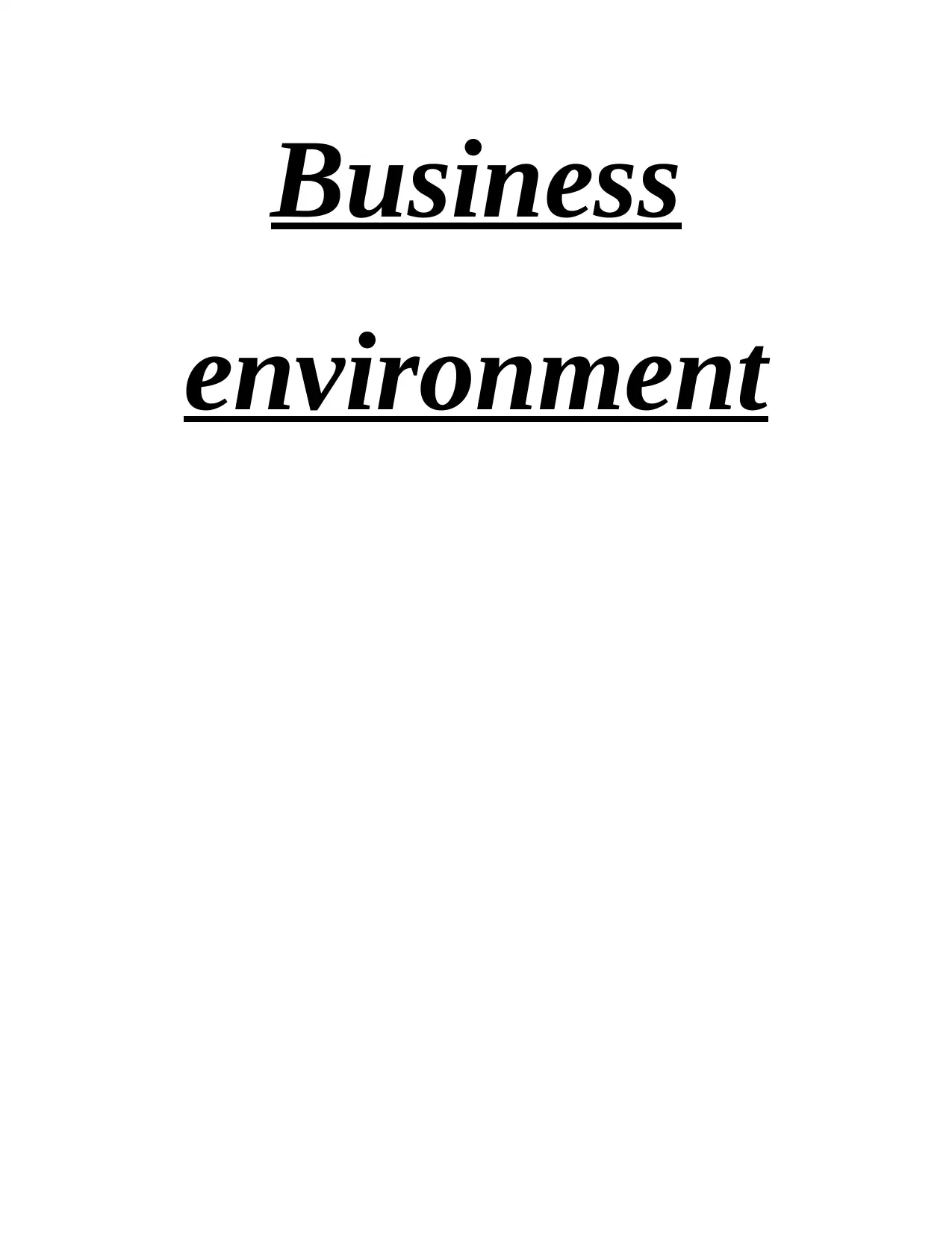
Business
environment
environment
Paraphrase This Document
Need a fresh take? Get an instant paraphrase of this document with our AI Paraphraser
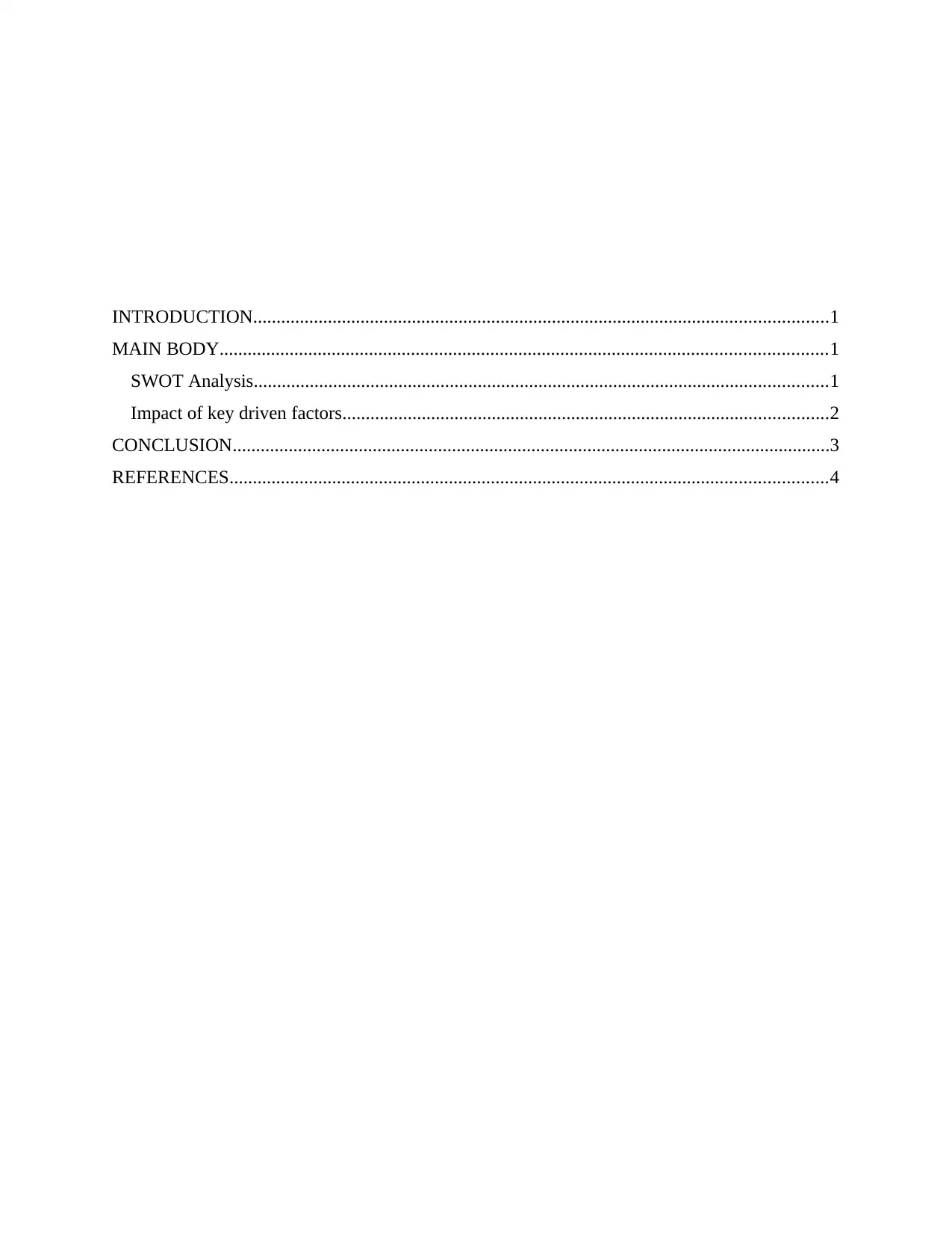
INTRODUCTION...........................................................................................................................1
MAIN BODY..................................................................................................................................1
SWOT Analysis...........................................................................................................................1
Impact of key driven factors........................................................................................................2
CONCLUSION................................................................................................................................3
REFERENCES................................................................................................................................4
MAIN BODY..................................................................................................................................1
SWOT Analysis...........................................................................................................................1
Impact of key driven factors........................................................................................................2
CONCLUSION................................................................................................................................3
REFERENCES................................................................................................................................4
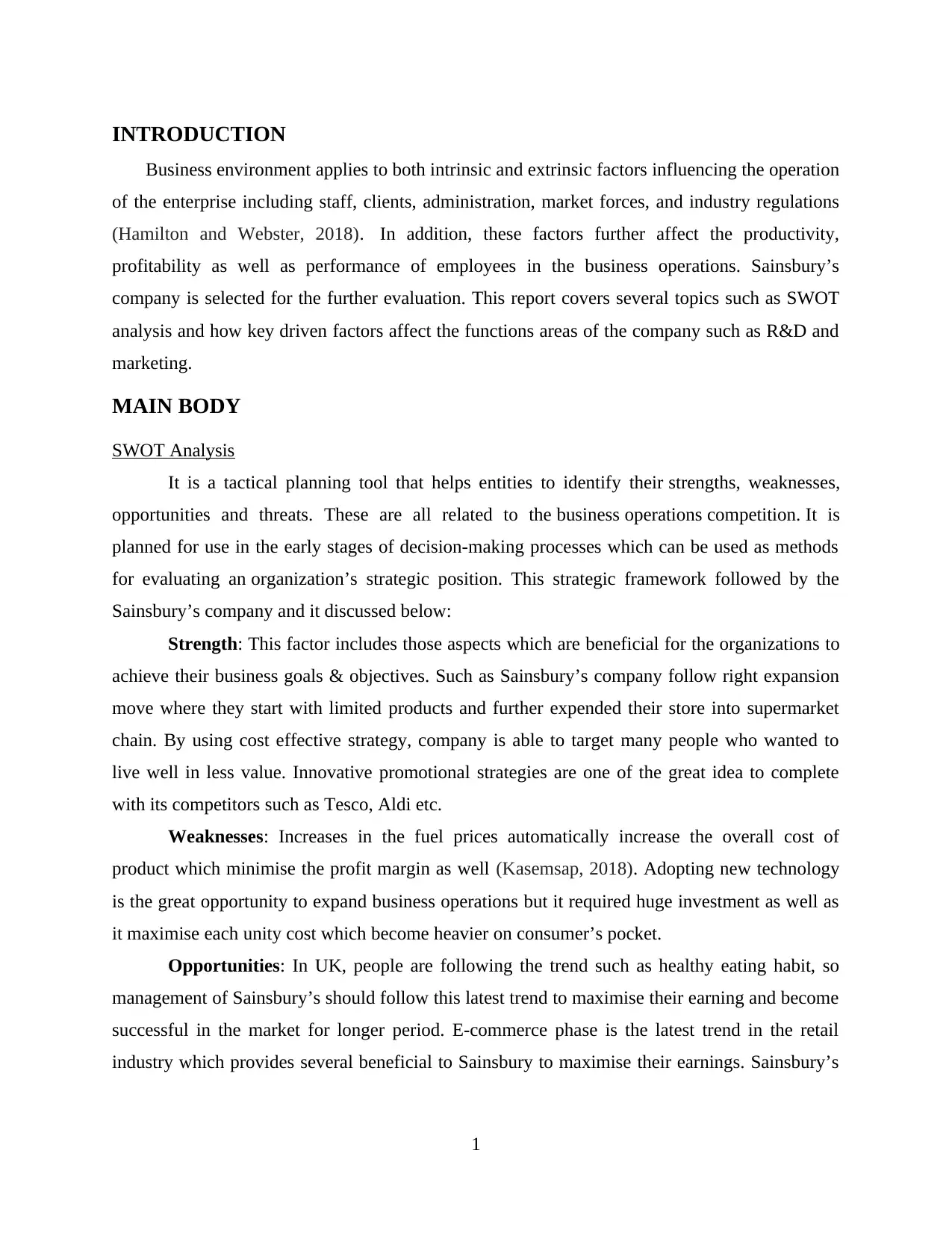
INTRODUCTION
Business environment applies to both intrinsic and extrinsic factors influencing the operation
of the enterprise including staff, clients, administration, market forces, and industry regulations
(Hamilton and Webster, 2018). In addition, these factors further affect the productivity,
profitability as well as performance of employees in the business operations. Sainsbury’s
company is selected for the further evaluation. This report covers several topics such as SWOT
analysis and how key driven factors affect the functions areas of the company such as R&D and
marketing.
MAIN BODY
SWOT Analysis
It is a tactical planning tool that helps entities to identify their strengths, weaknesses,
opportunities and threats. These are all related to the business operations competition. It is
planned for use in the early stages of decision-making processes which can be used as methods
for evaluating an organization’s strategic position. This strategic framework followed by the
Sainsbury’s company and it discussed below:
Strength: This factor includes those aspects which are beneficial for the organizations to
achieve their business goals & objectives. Such as Sainsbury’s company follow right expansion
move where they start with limited products and further expended their store into supermarket
chain. By using cost effective strategy, company is able to target many people who wanted to
live well in less value. Innovative promotional strategies are one of the great idea to complete
with its competitors such as Tesco, Aldi etc.
Weaknesses: Increases in the fuel prices automatically increase the overall cost of
product which minimise the profit margin as well (Kasemsap, 2018). Adopting new technology
is the great opportunity to expand business operations but it required huge investment as well as
it maximise each unity cost which become heavier on consumer’s pocket.
Opportunities: In UK, people are following the trend such as healthy eating habit, so
management of Sainsbury’s should follow this latest trend to maximise their earning and become
successful in the market for longer period. E-commerce phase is the latest trend in the retail
industry which provides several beneficial to Sainsbury to maximise their earnings. Sainsbury’s
1
Business environment applies to both intrinsic and extrinsic factors influencing the operation
of the enterprise including staff, clients, administration, market forces, and industry regulations
(Hamilton and Webster, 2018). In addition, these factors further affect the productivity,
profitability as well as performance of employees in the business operations. Sainsbury’s
company is selected for the further evaluation. This report covers several topics such as SWOT
analysis and how key driven factors affect the functions areas of the company such as R&D and
marketing.
MAIN BODY
SWOT Analysis
It is a tactical planning tool that helps entities to identify their strengths, weaknesses,
opportunities and threats. These are all related to the business operations competition. It is
planned for use in the early stages of decision-making processes which can be used as methods
for evaluating an organization’s strategic position. This strategic framework followed by the
Sainsbury’s company and it discussed below:
Strength: This factor includes those aspects which are beneficial for the organizations to
achieve their business goals & objectives. Such as Sainsbury’s company follow right expansion
move where they start with limited products and further expended their store into supermarket
chain. By using cost effective strategy, company is able to target many people who wanted to
live well in less value. Innovative promotional strategies are one of the great idea to complete
with its competitors such as Tesco, Aldi etc.
Weaknesses: Increases in the fuel prices automatically increase the overall cost of
product which minimise the profit margin as well (Kasemsap, 2018). Adopting new technology
is the great opportunity to expand business operations but it required huge investment as well as
it maximise each unity cost which become heavier on consumer’s pocket.
Opportunities: In UK, people are following the trend such as healthy eating habit, so
management of Sainsbury’s should follow this latest trend to maximise their earning and become
successful in the market for longer period. E-commerce phase is the latest trend in the retail
industry which provides several beneficial to Sainsbury to maximise their earnings. Sainsbury’s
1
⊘ This is a preview!⊘
Do you want full access?
Subscribe today to unlock all pages.

Trusted by 1+ million students worldwide
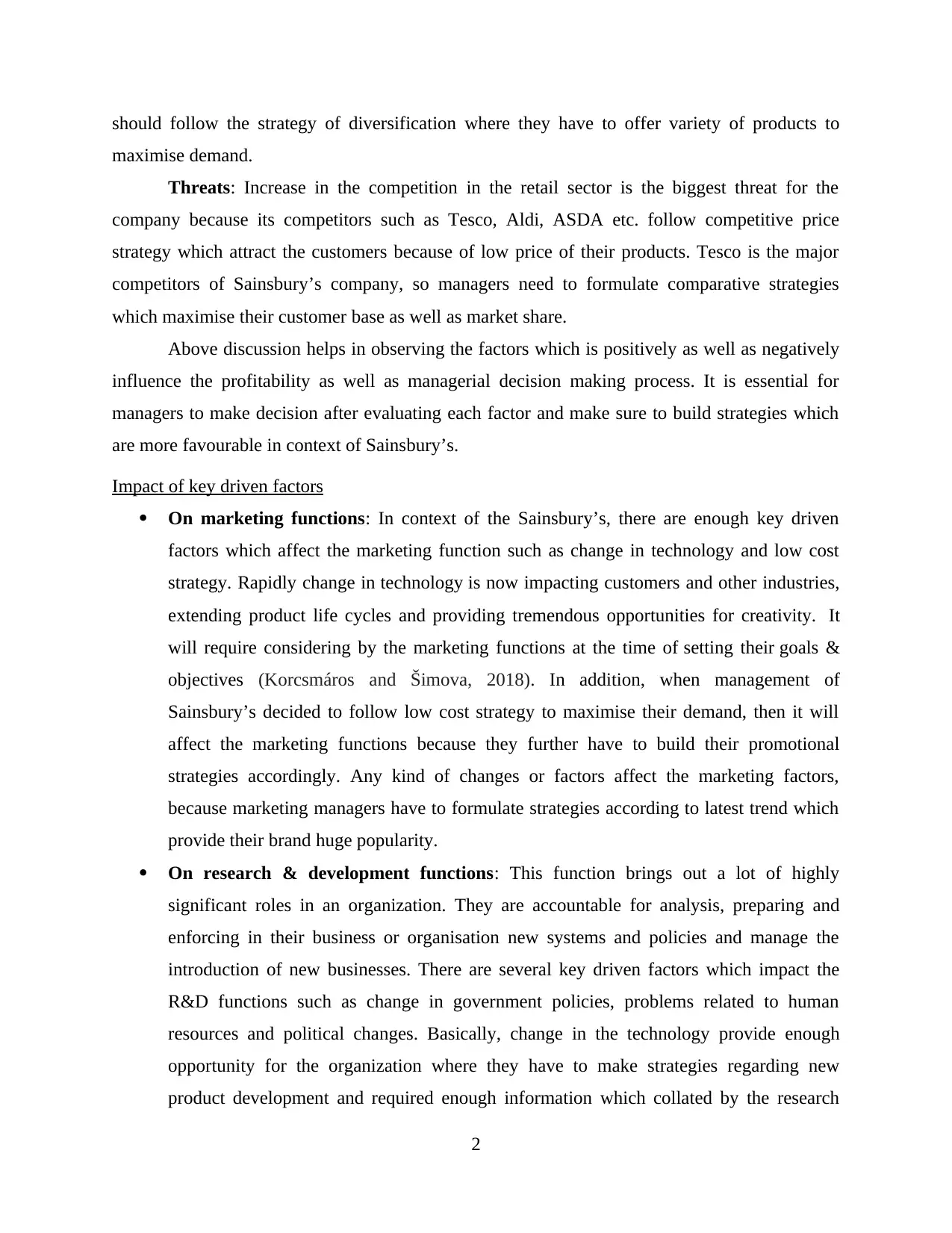
should follow the strategy of diversification where they have to offer variety of products to
maximise demand.
Threats: Increase in the competition in the retail sector is the biggest threat for the
company because its competitors such as Tesco, Aldi, ASDA etc. follow competitive price
strategy which attract the customers because of low price of their products. Tesco is the major
competitors of Sainsbury’s company, so managers need to formulate comparative strategies
which maximise their customer base as well as market share.
Above discussion helps in observing the factors which is positively as well as negatively
influence the profitability as well as managerial decision making process. It is essential for
managers to make decision after evaluating each factor and make sure to build strategies which
are more favourable in context of Sainsbury’s.
Impact of key driven factors
On marketing functions: In context of the Sainsbury’s, there are enough key driven
factors which affect the marketing function such as change in technology and low cost
strategy. Rapidly change in technology is now impacting customers and other industries,
extending product life cycles and providing tremendous opportunities for creativity. It
will require considering by the marketing functions at the time of setting their goals &
objectives (Korcsmáros and Šimova, 2018). In addition, when management of
Sainsbury’s decided to follow low cost strategy to maximise their demand, then it will
affect the marketing functions because they further have to build their promotional
strategies accordingly. Any kind of changes or factors affect the marketing factors,
because marketing managers have to formulate strategies according to latest trend which
provide their brand huge popularity.
On research & development functions: This function brings out a lot of highly
significant roles in an organization. They are accountable for analysis, preparing and
enforcing in their business or organisation new systems and policies and manage the
introduction of new businesses. There are several key driven factors which impact the
R&D functions such as change in government policies, problems related to human
resources and political changes. Basically, change in the technology provide enough
opportunity for the organization where they have to make strategies regarding new
product development and required enough information which collated by the research
2
maximise demand.
Threats: Increase in the competition in the retail sector is the biggest threat for the
company because its competitors such as Tesco, Aldi, ASDA etc. follow competitive price
strategy which attract the customers because of low price of their products. Tesco is the major
competitors of Sainsbury’s company, so managers need to formulate comparative strategies
which maximise their customer base as well as market share.
Above discussion helps in observing the factors which is positively as well as negatively
influence the profitability as well as managerial decision making process. It is essential for
managers to make decision after evaluating each factor and make sure to build strategies which
are more favourable in context of Sainsbury’s.
Impact of key driven factors
On marketing functions: In context of the Sainsbury’s, there are enough key driven
factors which affect the marketing function such as change in technology and low cost
strategy. Rapidly change in technology is now impacting customers and other industries,
extending product life cycles and providing tremendous opportunities for creativity. It
will require considering by the marketing functions at the time of setting their goals &
objectives (Korcsmáros and Šimova, 2018). In addition, when management of
Sainsbury’s decided to follow low cost strategy to maximise their demand, then it will
affect the marketing functions because they further have to build their promotional
strategies accordingly. Any kind of changes or factors affect the marketing factors,
because marketing managers have to formulate strategies according to latest trend which
provide their brand huge popularity.
On research & development functions: This function brings out a lot of highly
significant roles in an organization. They are accountable for analysis, preparing and
enforcing in their business or organisation new systems and policies and manage the
introduction of new businesses. There are several key driven factors which impact the
R&D functions such as change in government policies, problems related to human
resources and political changes. Basically, change in the technology provide enough
opportunity for the organization where they have to make strategies regarding new
product development and required enough information which collated by the research
2
Paraphrase This Document
Need a fresh take? Get an instant paraphrase of this document with our AI Paraphraser
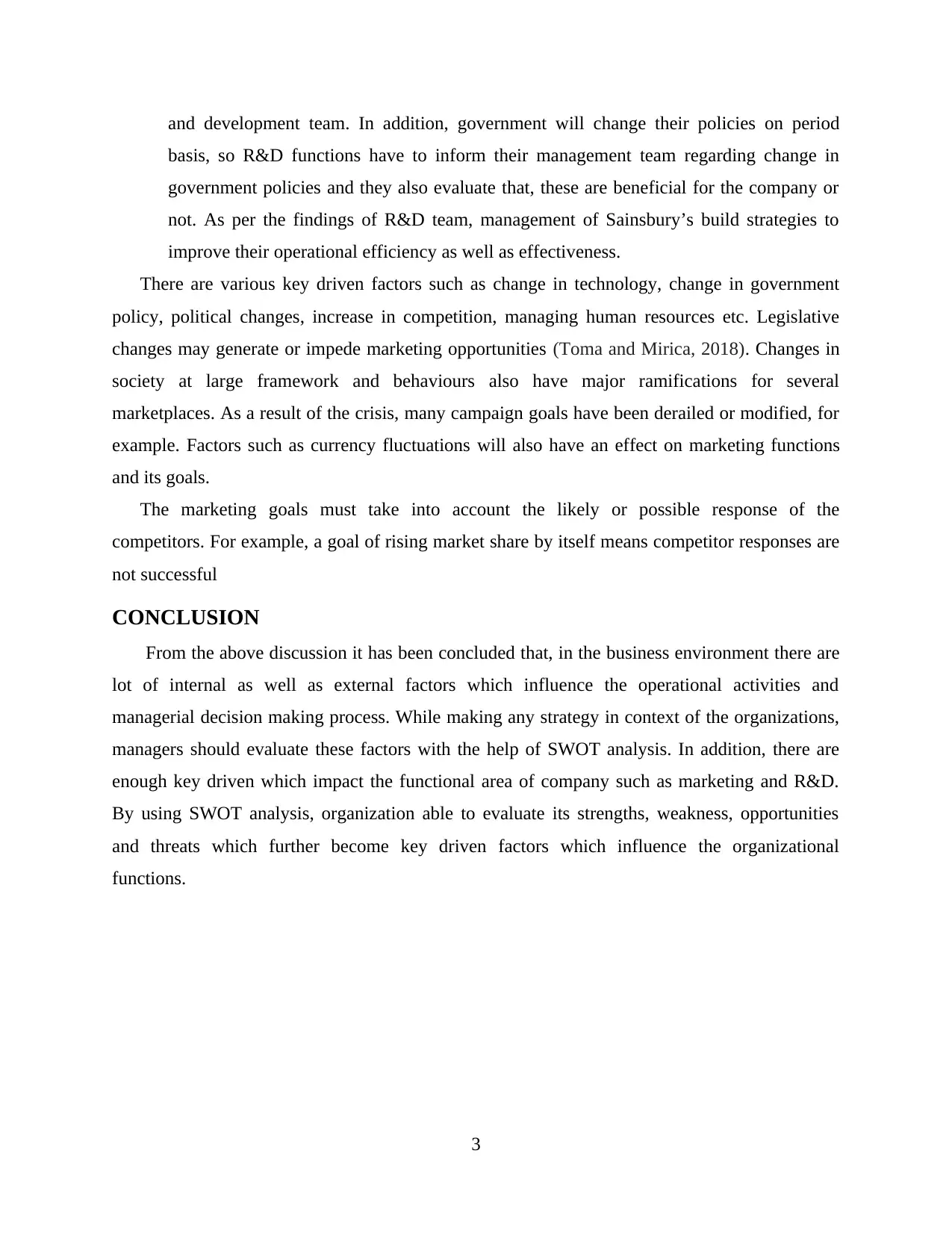
and development team. In addition, government will change their policies on period
basis, so R&D functions have to inform their management team regarding change in
government policies and they also evaluate that, these are beneficial for the company or
not. As per the findings of R&D team, management of Sainsbury’s build strategies to
improve their operational efficiency as well as effectiveness.
There are various key driven factors such as change in technology, change in government
policy, political changes, increase in competition, managing human resources etc. Legislative
changes may generate or impede marketing opportunities (Toma and Mirica, 2018). Changes in
society at large framework and behaviours also have major ramifications for several
marketplaces. As a result of the crisis, many campaign goals have been derailed or modified, for
example. Factors such as currency fluctuations will also have an effect on marketing functions
and its goals.
The marketing goals must take into account the likely or possible response of the
competitors. For example, a goal of rising market share by itself means competitor responses are
not successful
CONCLUSION
From the above discussion it has been concluded that, in the business environment there are
lot of internal as well as external factors which influence the operational activities and
managerial decision making process. While making any strategy in context of the organizations,
managers should evaluate these factors with the help of SWOT analysis. In addition, there are
enough key driven which impact the functional area of company such as marketing and R&D.
By using SWOT analysis, organization able to evaluate its strengths, weakness, opportunities
and threats which further become key driven factors which influence the organizational
functions.
3
basis, so R&D functions have to inform their management team regarding change in
government policies and they also evaluate that, these are beneficial for the company or
not. As per the findings of R&D team, management of Sainsbury’s build strategies to
improve their operational efficiency as well as effectiveness.
There are various key driven factors such as change in technology, change in government
policy, political changes, increase in competition, managing human resources etc. Legislative
changes may generate or impede marketing opportunities (Toma and Mirica, 2018). Changes in
society at large framework and behaviours also have major ramifications for several
marketplaces. As a result of the crisis, many campaign goals have been derailed or modified, for
example. Factors such as currency fluctuations will also have an effect on marketing functions
and its goals.
The marketing goals must take into account the likely or possible response of the
competitors. For example, a goal of rising market share by itself means competitor responses are
not successful
CONCLUSION
From the above discussion it has been concluded that, in the business environment there are
lot of internal as well as external factors which influence the operational activities and
managerial decision making process. While making any strategy in context of the organizations,
managers should evaluate these factors with the help of SWOT analysis. In addition, there are
enough key driven which impact the functional area of company such as marketing and R&D.
By using SWOT analysis, organization able to evaluate its strengths, weakness, opportunities
and threats which further become key driven factors which influence the organizational
functions.
3
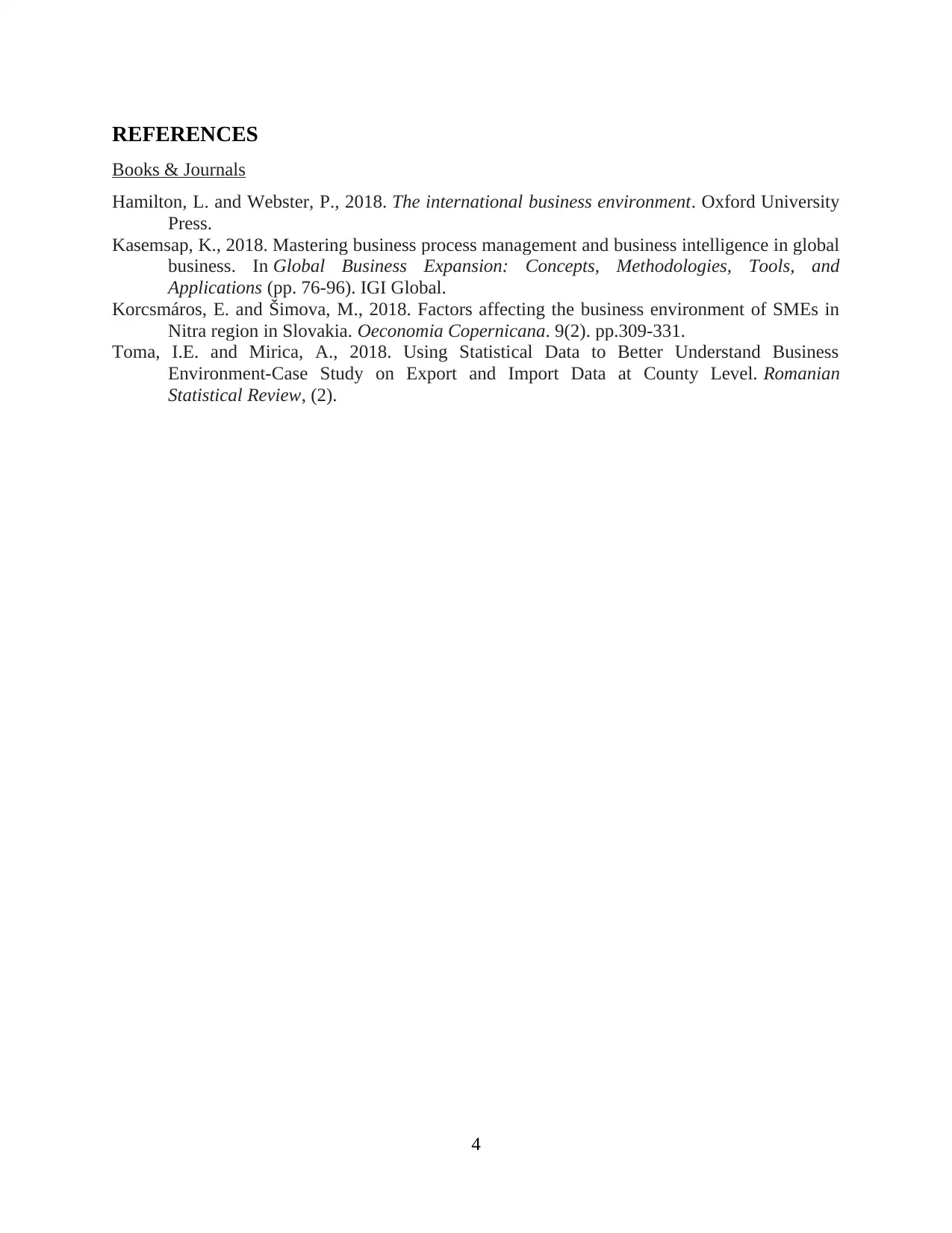
REFERENCES
Books & Journals
Hamilton, L. and Webster, P., 2018. The international business environment. Oxford University
Press.
Kasemsap, K., 2018. Mastering business process management and business intelligence in global
business. In Global Business Expansion: Concepts, Methodologies, Tools, and
Applications (pp. 76-96). IGI Global.
Korcsmáros, E. and Šimova, M., 2018. Factors affecting the business environment of SMEs in
Nitra region in Slovakia. Oeconomia Copernicana. 9(2). pp.309-331.
Toma, I.E. and Mirica, A., 2018. Using Statistical Data to Better Understand Business
Environment-Case Study on Export and Import Data at County Level. Romanian
Statistical Review, (2).
4
Books & Journals
Hamilton, L. and Webster, P., 2018. The international business environment. Oxford University
Press.
Kasemsap, K., 2018. Mastering business process management and business intelligence in global
business. In Global Business Expansion: Concepts, Methodologies, Tools, and
Applications (pp. 76-96). IGI Global.
Korcsmáros, E. and Šimova, M., 2018. Factors affecting the business environment of SMEs in
Nitra region in Slovakia. Oeconomia Copernicana. 9(2). pp.309-331.
Toma, I.E. and Mirica, A., 2018. Using Statistical Data to Better Understand Business
Environment-Case Study on Export and Import Data at County Level. Romanian
Statistical Review, (2).
4
⊘ This is a preview!⊘
Do you want full access?
Subscribe today to unlock all pages.

Trusted by 1+ million students worldwide
1 out of 6
Related Documents
Your All-in-One AI-Powered Toolkit for Academic Success.
+13062052269
info@desklib.com
Available 24*7 on WhatsApp / Email
![[object Object]](/_next/static/media/star-bottom.7253800d.svg)
Unlock your academic potential
Copyright © 2020–2025 A2Z Services. All Rights Reserved. Developed and managed by ZUCOL.





